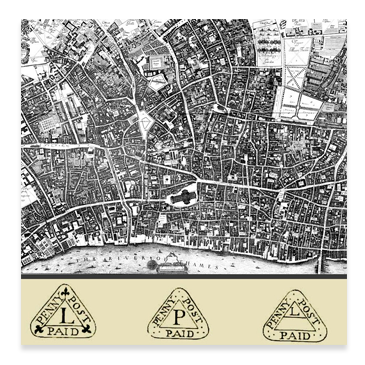
We have to go back to the year 1680 to find the first antecedent to the local stamp. It was then that the city of London introduced an internal postal system that cost one penny per letter, and which subsequently...
In 1840, when the modern postal service system was introduced, other local stamps began to appear. These were used in postal services that operated within a limited geographical area, generally within a city, an island, a region or along a particular transport route.
This type of stamp was often printed to make up for a shortage of official stamps, in certain cases, though there were also the stamps issued by regional authorities, with or without the authorisation of the central or higher government. Also included in this group were the many private stamps that were issued by dealers in order to increase their financial revenue.
In the Ramón Marull Collection we can find a number of different examples of local stamps, which possess a geographical and national range and richness that stretches all the way across the planet. And so, here are a few examples of this highly-varied type of stamp:
The first group is comprised of stamps issued for local postal correspondence in specific cities or regions. For example, the ones from Constantinople (now Istanbul) during the period of the Ottoman Turkish Empire were distributed by the company Liannos et Cie, founded in the city in 1865. Another example is the stamps issued by the cantons of Geneva and Vaud, during the transition period leading up to the constitution of the Federal State of Switzerland. Here are some of the stamps from this period:
The various conflicts that took place, often between nations but also including civil wars, have also led to stamps being issued by the provisional administrations of a territory or specific faction. These often represent clear examples of a political and propagandistic desire by the government bodies in question to legitimise their cause or political aims.
One example of the latter type can be found below. They were issued for local circulation by the military authorities of the city of Ersekë, during the period when the Epirote Greeks in Southern Albania set up an independent government they called the Autonomous Republic of Northern Epirus, in response to the signing of the Treaty of London (which brought the First Balkans War to an end).
Another example is the stamps issued by the Nationalist side during the Spanish Civil War (1936 – 1939). Here we can see a stamp commemorating the military meeting held in Tenerife to plan the coup d’état against the Republican Government. It was a locally-issued stamp, distributed only in the Canary Islands.
Finally, I would like to turn to a few exceptional or unusual cases of this type of local stamp. These examples were for official use, and were issued by a central authority that distributed them in a local area that had some kind of differential characteristic, such as its currency. I am referring specifically to a series from Nicaragua from 1900, especially overprinted in 1904 to be brought into circulation in the region of Cabo de Gracias a Dios, which was located in the old Nicaraguan province of Zelaya. This region, together with the town of Bluefields, made up the territory of the old Miskito Coast, a Protectorate of the British Empire that existed until 1894, when it became part of the Republic of Nicaragua.
We also have the stamps that were issued by private groups, businesses or companies that operated through an official concession granted by a central or local government. They effectively replaced postage, as they could charge transport routes, among other costs. These examples from the Ramon Marull Collection were issued by private companies that possessed full rights between the Venezuelan ports of La Guaira and Puerto Cabello and the island of Saint Thomas, up to the US Virgin Islands, thus establishing a maritime postal service line for the first time, in 1864. This privilege was initiated thanks to the concession acquired by Robert Todd’s shipping company, and was followed by other owners such as J.A. Jesurum & Zoon, a Dutch shipping company based in Curaçao, and the German company the Hamburg American Line. Finally, in 1875, the British shipping line the Royal Mail Steam Packet Company issued what would be the last local stamps for this maritime route.